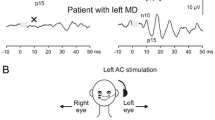Abstract
Otolith function in subjects with vitamin D deficiency/insufficiency is investigated through vestibular-evoked myogenic potentials (VEMP) and subjective visual vertical (SVV) testing. The study group included 62 patients with vitamin D deficiency/insufficiency (30 females, 32 males), with age range 24–56 years (40.6 ± 9.1). The control group included 44 healthy volunteers of similar age and gender distribution. The entire study group had: (1) serum level of 25-hydroxyvitamin D <30 ng/ml; (2) normal bone mineral density as indicated by dual-energy X-ray absorptiometry with T-score >−1; (3) normal middle ear function; (4) Age is ≤60 years. All subjects enrolled in the current study underwent audiovestibular evaluation consisting of pure-tone audiometry, immittancemetry, cervical VEMP (cVEMP), ocular VEMP (oVEMP), and SSV. The entire control group had normal cVEMP, two subjects had abnormal oVEMP. Thirty-three subjects (53 %) in the study group had abnormal oVEMP and 31 subjects (50 %) had abnormal cVEMP. Forty-one (66 %) had abnormal VEMP when abnormal VEMP was considered as either abnormal oVEMP or cVEMP. The entire control and study groups had normal SSV test results. Vitamin D deficiency may be associated with development of otolith dysfunction affecting both the utricle and saccule. This was suggested by the high prevalence of abnormal ocular vestibular-evoked myogenic potentials (oVEMP) and cervical vestibular-evoked myogenic potentials (cVEMP) in the study group.



Similar content being viewed by others
References
Holick MF, Chen TC (2008) Vitamin D deficiency: a worldwide problem with health consequences. Am J Clin Nutr 87(4):1080S–1086S
Al-Mohaimeed A, Khan N, Naeem Z, Al-Mogbel E (2012) Vitamin D status among women in middle east. J Health Sci 2(6):49–56
Zou J, Minasyan A, Keisala T, Zhang Y, Wang JH, Lou YR et al (2008) Progressive hearing loss in mice with a mutated vitamin D receptor gene. Audiol Neurootol 13(4):219–230
Yamauchi D, Nakaya K, Raveendran NN, Harbidge D, Singh R, Wangemann P et al (2010) Expression of epithelial calcium transport system in rat cochlea and vestibular labyrinth. BMC Physiol 10:1–12
Brookes GB (1983) Vitamin D deficiency: a new cause of cochlear deafness. J Laryngol Otol 97(5):405–420
Jeong SH, Kim JS, Shin JW, Kim S, Lee H, Lee AY, Kim JM, Jo H, Song J, Ghim Y (2013) Decreased serum vitamin D in idiopathic benign paroxysmal positional vertigo. J Neurol 260(3):832–838
Nagai N, Ogawa Y, Hagiwara A, Otsuka K, Inagaki T, Shimizu S et al (2014) Ocular vestibular evoked myogenic potentials induced by bone-conducted vibration in patients with unilateral inner ear disease. Acta Otolaryngol 134:151–158
Nechel C, Toupet M, Bodsona I (2001) The subjective visual vertical in otolith functions and disorders. In: Tran Ba Huy P, Toupet M (eds). Adv Otorhinolaryngol. Basel, Karger. (58): 77–87
Pavan TZ, Funabashi M, Carneiro JA, Pontelli TE, Tedeschi W, Colafêmina JF et al (2012) Software for subjective visual vertical assessment: an observational cross-sectional study. Braz J Otorhinolaryngol 78(5):51–58
Nakaya K, Harbidge DG, Wangemann P, Schultz BD, Green ED, Wall SM et al (2007) Lack of pendrin HCO3- transport elevates vestibular endolymphatic [Ca2+] by inhibition of acid-sensitive TRPV5 and TRPV6 channels. Am J Physiol Renal Physiol 292(5):F1314–F1321
Yamauchi D, Raveendran NN, Pondugula SR, Kampalli SB, Sanneman JD, Harbidge DG et al (2005) Vitamin D upregulates expression of ECaC1 mRNA in semicircular canal. Biochem Biophys Res Commun 331(4):1353–1357
Vibert D, Sans A, Kompis M, Travo C, Muhlbauer RC, Tschudi I, Boukhaddaoui H, Häusler R (2008) Ultrastructural changes in otoconia of osteoporotic rats. Audiol Neurootol 13(5):293–301
Francis J, Bonner J, Grabois M, Shipp K, Lindsay J, Gold D (2003) Health professional’s guide to rehabilitation of the patient with osteoporosis. Osteoporos Int 14(Suppl 2):S1–S22
Jang YS, Kang MK (2009) Relationship between bone mineral density and clinical features in women with idiopathic benign paroxysmal positional vertigo. Otol Neurotol 30:95–100
Curthoys IS, Iwasaki S, Chihara Y, Ushio M, McGarvie LA, Burgess AM (2011) The ocular vestibular-evoked myogenic potential to air-conducted sound; probable superior vestibular nerve origin. Clin Neurophysiol 122:611–616
Eryaman E, Oz I, Ozker B, Erbek S, Erbek S (2012) Evaluation of vestibular evoked myogenic potentials during benign paroxysmal positional vertigo attacks; neuroepithelial degeneration? B-ENT 8(4):247–250
Talaat HS, Metwaly MA, Abdelrouf H, Khafagy A, Isak H (2013) Vestibular evoked myogenic potentials in idiopathic posterior canal benign paroxysmal positional vertigo. Hear Balance Commun 11(4):176–181
Cnyrim C, Rettinger N, Mansmann U, Brandt T, Strupp M (2007) Central compensation of deviated subjective visual vertical in Wallenberg’s syndrome. J Neurol Neurosurg Psychiatry 78:527–528
Conflict of interest
None.
Author information
Authors and Affiliations
Corresponding author
Rights and permissions
About this article
Cite this article
Sanyelbhaa, H., Sanyelbhaa, A. Vestibular-evoked myogenic potentials and subjective visual vertical testing in patients with vitamin D deficiency/insufficiency. Eur Arch Otorhinolaryngol 272, 3233–3239 (2015). https://doi.org/10.1007/s00405-014-3395-6
Received:
Accepted:
Published:
Issue Date:
DOI: https://doi.org/10.1007/s00405-014-3395-6




